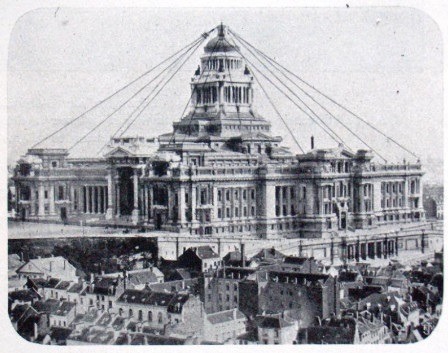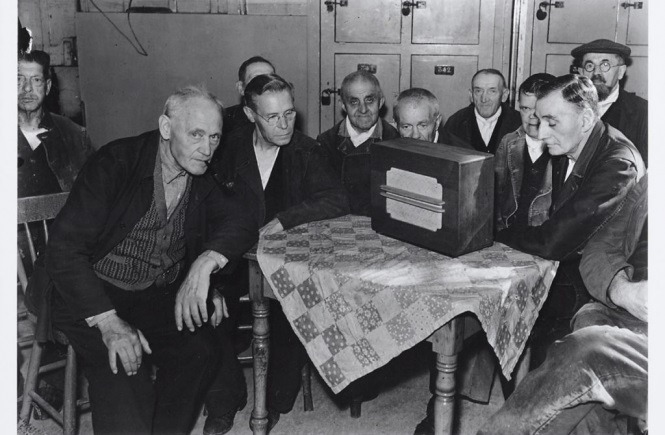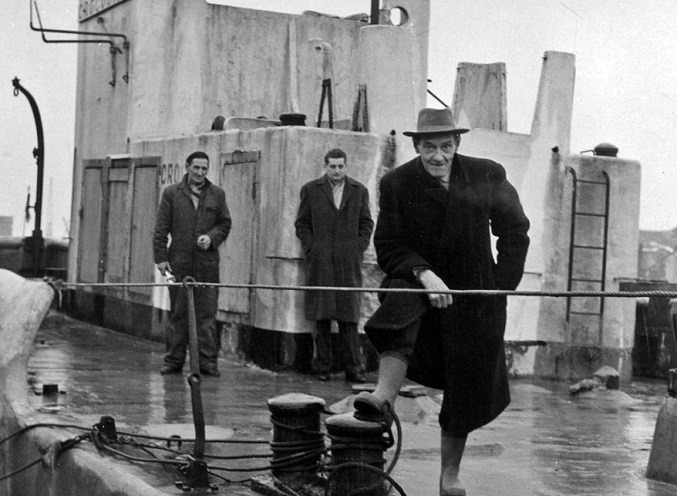After the Second World War, the Belgian government wanted to have complete control over the airwaves. They consequently seized and destroyed any radio station that did not have a license. For a long time, Belgians could only listen to public radio, which had very limited programming.
Tired of government-approved music, monolingual programs and establishment views, activists and music lovers set up hidden stations in garages, basements, church towers and garden sheds. Some even took to boats in order to escape authorities’ efforts to shut them down. While there are almost no Belgian pirate radio stations left today, history shows that despite the odds, a new wave of clandestine radios can conquer the air any time.
Humble origins
The first antenna to send out radio signals in Belgium was built in 1908 on top of the Palace of Justice. The historic building’s entire roof was covered with antenna cables sending radio signals as far as Liège. Five years later, an Italian engineer developed a low-power wave transmitter in a garden shed of the Castle of Laeken. Together with a few other employees of the Royal Court, he sent experimental broadcasts with voices and music from eight pillars over 100 meters tall in the royal gardens.
Inspired by Queen Elizabeth’s passion for music, King Albert I requested a radio receiver. The first ever radio concert in Europe was transmitted in Belgium on a March night in 1914, when the king and queen listened to an aria of the opera Tosca on their radio.

Palais de Justice covered in radio antenna and cables in 1908
After the first royal success, the newly formed Ministry of Telephony and Telegraphy, RTT, started transmitting spoken messages and live concerts. With only a dozen radios in Belgium, the programmes were occasions for groups of wealthy friends to gather around the radio for an hour and marvel at the new and exclusive technology.
During the Great War, King Albert wanted the antennas at the palace and royal gardens to be destroyed, fearing the Prussian Army would take them. The sense of fear continued through the aftermath of the war, when officials regarded sending and receiving radio signals as a potential danger for national security. Everyone who wanted a radio needed to get permission from the RTT, and in 1920 there were only 26 registered radios in Belgium.

Broadcaster at Radio Bruxelles studio in 1924
One of the main radio producers, Société Belge Radio-électrique, based in Brussels, decided to create its own radio station to boost sales. Their station, Radio Bruxelles, went on air in 1922 with classical music recordings and programs in French discussing the weather, news and sports. But it was not easy to listen to the station if you lived outside of Brussels. One enthusiast sent the following letter about his trials to get a good signal to Belgium’s monthly Radio Magazine: “I bought a small radio with a galena stone. I live at least 60 kilometres from Brussels. I made an air wire that I hung outside, seven to eight metres high and 25 metres long. Then I added another 20 metres of wire and another one of 33 metres.”

Group of men gathering to listen to radio in Brussels, early 20th century.
When this elaborate construction did not result in a better signal, the man built another antenna: “Then I made a construction hidden from my neighbours, spanning four wires in my attic of all kinds: fine, coarse, zinc, copper, iron; a mixture of everything, soldered and tied together. With this wire, I have the best connection one can imagine.” Now, the Brussels broadcasts came in clear, and the enthusiast even picked up foreign signals. “After the concerts at 10 o’clock I can still silently hear people talking, but also singing and music. I don’t know where it is coming from; it’s on the same wavelength as Brussels. I thought I heard English, is that possible?”
In the 1920s and early 1930s, Flemish enthusiasts who wanted an alternative to the solely French programming installed transmitters in church towers, mills and potato fields to air their own programs. By 1932, the government decided to limit these free radio enterprises and shut down at least 37 illegal radio stations. Seven years later, there were over one million radios in Belgium.
Monopoly
During the German occupation of the Second World War, only Radio Bruxelles was allowed to transmit programs, which all consisted of Nazi propaganda. Many Belgians secretly turned to listening to the UK’s BBC transmissions. Belgian public broadcasters cooperated with the resistance to set up clandestine radio stations. The secret radio broadcasting operation was called Samoyede.
At one point, German forces tried to irrevocably damage the Flagey building in Brussels, which had a radio studio used by the resistance. German soldiers poured in oil, started a fire and tried to flood the building. As soon as the Nazi soldiers left, Samoyede member Jozef van Gaelen got into the building through a small basement entrance, put out the fires and closed the water and oil valves. He reopened the building for the public and started repairing the studio. Before finishing the repairs, Van Gaelen was stopped by German troops at the Namur Gate. He was carrying radio equipment and the soldiers shot him dead.
To the Seas
After the Second World War, the Belgian government decided to keep the radio monopoly instated by the German occupiers. None of the free radio stations from before the war were allowed to air any programmes, so many went underground.
Georges de Caluwé, who had founded one of the first free Flemish radio stations in the 1920s, which he transmitted from a church tower, established a political party to fight for the rights of independent radio. In 1955, he started his own illegal post-war broadcasting station, which was shut down in a matter of days.
Belgian public broadcasters were legally designated to be the sole transmitters of radio and TV programmes. Untouchable, their programmes did not need to appeal to the public and became vehicles for the state and politicians.
De Caluwé and his party sent an ultimatum to the ministry of radio: either they allowed free private radio or he would position a ship in front of the Belgian coast and broadcast his programmes from there. Seeing that the government was not ready to budge, De Caluwé, who was in his seventies by then, bought an old 585-tonne ship from the French Marines called Le Crocodile for 2.5 million old Belgian Francs (60,000 euro).

Georges de Caluwé on his ship, Uilenspiegel. Determined to fight for the right to broadcast independent radio, he created Belgium’s first pirate radio in October 1962, Radio Antwerpen.
In October 1962, Belgium’s first pirate radio, Radio Antwerpen, was transmitted from the ship, redubbed the “Uilenspiegel,” on the North Sea near Knokke-Heist. The crew recorded the programs on shore and brought them to the ship using a small boat called “Nele”. Just like he had climbed the church tower in the 1920s to make sure his radio programs could be transmitted, De Caluwé climbed from ship to ship every day at the age of 73.
Besides airing Flemish, French and classical music programs, Radio Antwerpen also played popular music and oldies, and had an afternoon slot for requests. A few weeks after they started broadcasting, the pirates invested in short wave transmission equipment, and Radio Antwerpen could be picked up as far as Canada. After authorities organized multiple raids at their on-shore recording studio, the crew decided to record their programs on the go. They regularly changed their meeting place and everyone brought a separate piece of equipment.
On Dec. 17, 1962, a heavy storm with wind gusts of over 100 kilometres per hour broke the radio equipment and anchor of the Uilenspiegel. The crew couldn’t send out a distress signal because the generators broke as well. Floating around in the storm, they shot off flares, which got the attention of an English ferryboat that, in turn, notified the coast guard.
The rescue operation did not go well. One person died after getting injured when jumping from the radio ship to the coast guard’s rescue boat. Even the ship did not make it to safety. While dragging the Uilenspiegel towards shore and fighting the strong current, a towboat‘s towing cable broke. The rogue vessel reached its final resting place after drifting onto a Dutch beach near Cadzand.

Uilenspiegel was bought from the French Marines for 2.5 million Belgian Francs (60,000 euro at the time). It was an old 585-tonne ship previously called Le Crocodile.
Four days before the demise of his ship, De Caluwé had passed away in Antwerp after being hospitalised. His condition had been deteriorating. “He had lost a lot of weight, you saw he was tired and in pain,” his granddaughter told public broadcasters. A few days after the ship had stranded, the Belgian parliament passed a law forbidding anyone to work on radio transmissions from sea. The ship became a tourist destination until it fell into disrepair and became dangerous for the public. In 1971, the Dutch government blew up the ship.
Onshore
After the success of Radio Antwerpen in 1962, many onshore enthusiasts went on air, using medium wave radio transmitters. Most programmes were on at night and in the weekend. They usually played requests, which in the sixties meant a lot of The Beatles, The Shadows and Belgian singer Will Tura. The radio stations also organized humanitarian actions such as collecting toys for children in hospitals.
Immensely popular, free radio became a competitor to national broadcasters. While the Dutch government quickly created a popular radio station of their own, Belgian public broadcaster BRT was so tangled in its own red tape that they couldn’t get one on air in time. The government cracked down on the new wave of free radio in 1965 and most of the free stations were seized. After many of the radio owners and presenters were convicted in 1966, authorities re-established their control over what Belgians could listen to.
But by the summer of 1973, another Belgian pirate radio came on air. An Antwerp businessman had bought one of the ships that had been used to broadcast the famous British pirate station Radio Caroline. The ship transmitted Radio Atlantis, a popular music station that later turned into Radio Mi Amigo, which would become Belgium’s most listened to pirate radio.
Radio Mi Amigo, airing Dutch-speaking singers shunned by public broadcasters, had a rocky history of changing ships, crew and locales – at one point it was even broadcasting from Spain. It went off the air many times but always came back and cooperated with various other pirate radios, including Radio Caroline, until the station’s ship was seized in 1979.
Protest Radios
By the late 1970s, a movement of political pirate radios took over the airwaves. Run by environmental groups, student organizations and activists, many had subversive political agendas. The stations were strictly covert operations; broadcasting at irregular times and from different locations. Most of them evaded seizure by the RTT, Belgium’s radio agency that was initially founded to transmit the country’s first radio signals from a royal garden shed.
The first protest radio station came on air in 1978 to stop the construction of a dam on a small river in Wallonia. The environmentalists behind Radio Couvin and Radio Eau Noire knew the RTT would try to shut them down, so they organized themselves like the resistance radio of the Second World War. One volunteer would create a 10-minute programme at home using a tape recorder and drop the cassette in a mailbox where another volunteer picked it up. A third volunteer placed an antenna in a tree and a fourth started the generator, ran the radio transmitter and aired the recording.
Many others followed, such as Radio Noir, Radio Verte and Radio Tam Tam. Most were based in Wallonia and had talk shows discussing nuclear power plants and soft drugs. Around the same time, student movements created radio stations to protest against an increase in tuition fees.
When police trucks and RTT authorities were seen near their campus, Radio Louvain-la-Neuve asked their listeners to step in. Within five minutes, 1,500 students were blocking the authorities’ access to the campus buildings and some started throwing bricks and pieces of wood. The police and the RTT left the campus without seizing anything or questioning anyone. At other manifest radio stations, authorities were welcomed with buckets of hot water or a hunting shotgun.
Radio Rubbish
At the free University of Brussels, students started Radio Brol, meaning Radio Rubbish, in 1978 to protest tuition increases. The university also aired anti-nuclear and anti-racism radio stations run by students. While these political stations had irregular and temporary schedules, by 1979, Brussels also had many pirate radio stations that were on air all day. These free radios brought together Dutch-speaking, French-speaking and international listeners and played the popular hits people were eager to hear.
Radio Capitale aired live shows from the Martini Tower at Place Rogier, which was demolished in 2004. Three days a week, the programming was in Dutch and the other half of the week, presenters spoke in French and English. The station played a lot of New Wave, Reggae and Ska, and interviewed famous artists such as Marvin Gaye and Mike Oldfield, until it was seized by the authorities.
The early 1980s saw an explosion of free and independent radio stations across Belgium. Brussels airwaves in particular were filled with dozens of radio stations from Radio Plus’ alternative rock and anti-hit list programming to the collective Radio z’Alternatives, which described itself as a station of “art, alternative music, noise and sounds.” The times were marked by RTT raids, a race to dominate frequencies, increasingly strong transmitters, sabotage by competing stations, home-made studios, and experimental programming including absurd, nonsensical talk shows and niche genres such as Cold Wave.
When the mayor of Schaarbeek pushed for anti-immigrant policies in 1983, Radio Panik was created to give a voice to minorities. After short stints at two houses in Schaerbeek, Radio Panik moved to an abandoned military barracks at Place Dailly. The building had been in disrepair for ten years and a group of immigrants fixed the water, electricity, gas, walls and rooms. The multicultural station aired Albanian, Belgian, Congolese, Greek, Portuguese, Spanish and Turkish shows.
Radio Contact
Based in a basement accessible only through a maze of corridors behind a row of blighted houses near the Atomium, Radio Contact aired continuous music broadcasts across Brussels for 16 hours a day. One month later, they started producing their own bilingual shows with radio presenters in both Dutch and French. When the station organized a concert in June 1980, they invited popular bands of the time, such as Plastic Bertrand, and created a temporary pirate TV station to air the concerts. Between 1980 and 1987, the station was seized 17 times. In 1987, it was officially recognized and no longer a pirate radio. Today it is one of the most listened to radio station in Belgium.
The hundreds of pirate radios established in the 1980s, when almost every village had its own station, died off after government crackdowns or running out of money. Those that transitioned to licensed and commercial broadcasting lost their initial subversive character. While Belgian regulatory and government agencies exert rigid control over the airwaves at the moment, the next group of pirate radios might just be around the corner.

